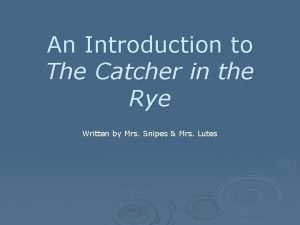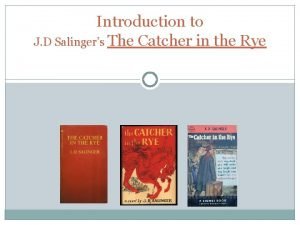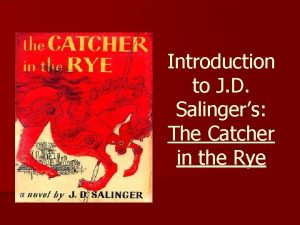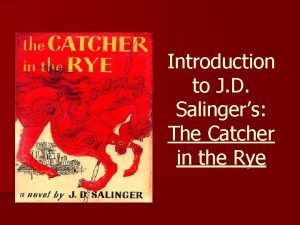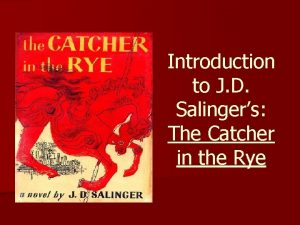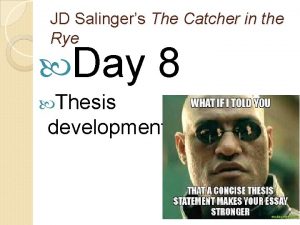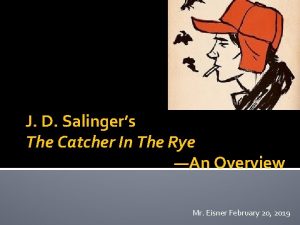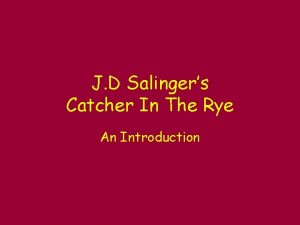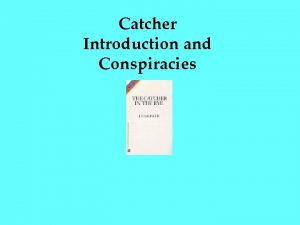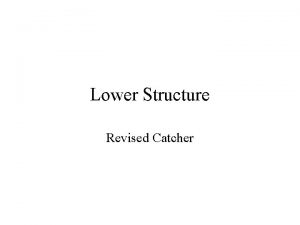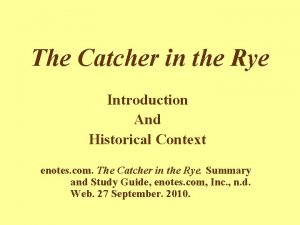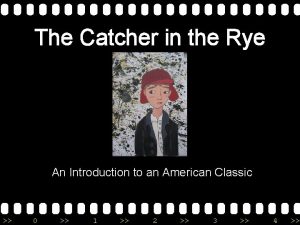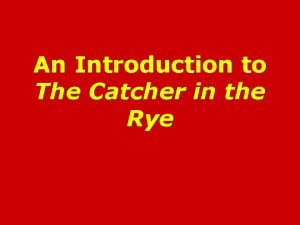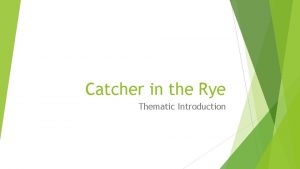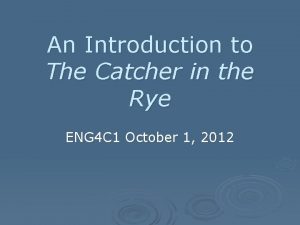Introduction to J D Salingers The Catcher in




















- Slides: 20

Introduction to J. D. Salinger’s: The Catcher in the Rye

J. D. Salinger 1919 – 2010 n Has written several books about young people including The n Catcher in the Rye and Franny and Zoey Served in WWII n Was extremely private and a recluse. n

J. D. Salinger n Jerome David Salinger n Drafted into the army n Was in Normandy for D Day n Marched into and helped liberate concentration camps n Created Holden Caulfield, our main character, during WWII n After the war, hospitalized after suffering a nervous breakdown

The Catcher in the Rye n n n Published in 1951 Has sold over 65 million copies world wide! Despite its popular success, the critical response to The Catcher in the Rye was slow in getting underway. One of the most frequently challenged books in library history because of sex and vulgar language. Named one of the best novels of the 20 th century by Time Magazine.

Reasons for Banning? n. Until 2006, Catcher in the Rye was one of the most frequently banned books. n Mark David Chapman (assassin of John Lennon) and John Hinckley Jr. (attempted assassin of President Ronald Reagan) both had copies of the book in their pockets when they were arrested.

The Catcher in the Rye n n Tells the story of a teenager expelled from his high school and his journey across NYC in the 1950’s. Is considered to be a bildungsromana type of novel concerned with the education, devel opment, and maturing of a young protagonist. Issues discussed in the book include: school, teachers, music, sex, alcohol, hypocrisy, family, and being a teenager. A story is about Holden Caulfield, the 16 year old protagonist of the novel, and his experiences in school and New York City.

Holden’s Character Holden Caulfield = sketch of an American teenager n Nearly all readers identify with or see some of their friends reflected in different aspects of Holden’s character. n Young readers see in Holden Caulfield a little bit of what they are, while older readers see in Holden a bit of what they once were. n

Similarities between J. D. Salinger and Catcher in the Rye n Both grew up in Manhattan, New York n Both flunked out of school and attended military school in Pennsylvania n Both have been referred to as liars n Both use alienation as a form of self preservation n Both were scorned by a love interest and lashed out in anger

Point of View n First-person limited- we see this story only through Holden’s eyes n “You”- the psychoanalyst and the reader n Stream of Consciousness-many digressions as we are in the head of Holden n Dialect- Salinger perfected the dialect of the teenage boy – This language is the cause of much controversy over the book – This creates a very believable character

Topics n Phonies/Societal Pressures – “phony” implies snobbery – Holden hates phonies n Adolescence/ Loss of Innocence – Holden is at the in between stage of life, in between a child an adult – Holden wants to be accepted by children and adults, however, he does not fit into either category

Themes Within Catcher in the Rye n Alienation for Self Preservation n Conformity versus Resistance n Perception of Truth n Loss of Innocence

Dominant Symbols n The Carousel n The Red Hunting Cap n The Catcher’s Mitt n The Ducks in Central Park Pond n The Museum of Natural History n Pencey Prep

Holden’s Quests n Holden is looking for THREE things: – The Innocence of Childhood § Wants things to remain the same as when he was younger – Love – Identity § What do I do with my life? What does this all mean? § How do I live up to expectations and still be an individual?

What to look for while reading? n This novel is a character study of Holden. – Analyze Holden’s motivations, his personality, and his mental stability. – What’s Holden’s deal? Is there something wrong with him (is he crazy? ) or is he a just a normal teenager?

Stream of Consciousness n Stream of Consciousness is a writing technique in which a person writes continuously for a set period of time without regard to spelling, grammar, or topic. It produces raw, often unusable material, but allows the writer to overcome blocks of apathy and selfcriticism.

Stream of Consciousness n Purpose: This type of writing aims at expressing in words the flow of a character’s thoughts and feelings in their minds. The technique aspires to give readers the impression of being inside the mind of the character. Therefore, the thoughts of the character sheds light on plot and motivation in the novel.

Stream of Consciousness n Write what comes to your mind as you are thinking. Do not worry about grammar or spelling. Do not censor your feelings and use describing words that are vivid and meaningful. n 5 minutes worth of writing. Do not put your pens down!

Stream of Consciousness n Possible Topics to write about if you are stuck: Your earliest childhood memories A recent dream A family member List your favorites sounds A regret Your favorite place A pet Your most prized possession Something that frightens you Your style of clothing Friends

What’s going on during first (1945) and second (1946) publishing n n n n n TRENDS AND FADS: The birthrate stands at 2. 4 births per thousand women. There are 18, 610, 000 employed outside their homes; the Women's Bureau reports that 80 percent of them want to continue working after the war. Children buy Defense Stamps weekly; schools have air-raid drills. Toys are scarce; stores have no bicycles, skates, sleds, or electric trains. Laid off because their jobs have been given to returning veterans, women autoworkers stage a protest march with posters reading "Stop Discrimination Because of Sex. " On May 21, the U. S. Supreme Court affirms the right of states to recognize or reject Nevada divorce decrees. In February, the U. S. government imposes a midnight curfew on entertainment nationwide. The curfew is lifted in May. In August, gasoline rationing ends. In November, all previously rationed items except sugar are available. In December, many families take their first vacations since the bombing of Pearl Harbor. In December, cabaret shows open in many cities. They are by-products of the army's USO shows for the troops. On December 24, the National Community Christmas Tree is lit by President Harry Truman for the first time since 1941.

1946 n n n TRENDS AND FADS: The Baby Boom begins; the birthrate is up 20 percent over 1945. Seventy-four percent of couples have their first child during their first year of marriage. Dr. Benjamin Spock's The Commonsense Book of Baby and Child Care is published. The cost of living has increased 33 percent since 1941, creating dissatisfaction among consumers. � On July 2, for the first time since Reconstruction African Americans vote in the Mississippi Democratic primary. On September 15, the Federal Security Agency reports a rise in the proportion of divorces to marriages, but this up-surge in divorce is shortlived and soon overshadowed by a much larger and longer-lasting increase in marriage. In September, speaking before the American Legion, FBI director J. Edgar Hoover warns of 100, 000 communist operatives who have infiltrated U. S. organizations. On December 5, President Harry Truman's Executive Order 9809 establishes the President's Committee on Civil Rights.
 The catcher in the rye introduction
The catcher in the rye introduction Catcher in the rye introduction
Catcher in the rye introduction Jane gallagher inner desires
Jane gallagher inner desires Hát kết hợp bộ gõ cơ thể
Hát kết hợp bộ gõ cơ thể Frameset trong html5
Frameset trong html5 Bổ thể
Bổ thể Tỉ lệ cơ thể trẻ em
Tỉ lệ cơ thể trẻ em Voi kéo gỗ như thế nào
Voi kéo gỗ như thế nào Chụp tư thế worms-breton
Chụp tư thế worms-breton Chúa yêu trần thế alleluia
Chúa yêu trần thế alleluia Các môn thể thao bắt đầu bằng tiếng chạy
Các môn thể thao bắt đầu bằng tiếng chạy Thế nào là hệ số cao nhất
Thế nào là hệ số cao nhất Các châu lục và đại dương trên thế giới
Các châu lục và đại dương trên thế giới Công thức tính độ biến thiên đông lượng
Công thức tính độ biến thiên đông lượng Trời xanh đây là của chúng ta thể thơ
Trời xanh đây là của chúng ta thể thơ Cách giải mật thư tọa độ
Cách giải mật thư tọa độ Làm thế nào để 102-1=99
Làm thế nào để 102-1=99 Phản ứng thế ankan
Phản ứng thế ankan Các châu lục và đại dương trên thế giới
Các châu lục và đại dương trên thế giới Thơ thất ngôn tứ tuyệt đường luật
Thơ thất ngôn tứ tuyệt đường luật Quá trình desamine hóa có thể tạo ra
Quá trình desamine hóa có thể tạo ra
